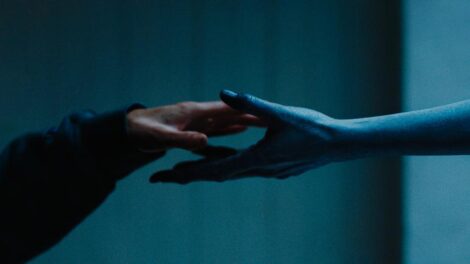
Inspired by the childhood trauma of his father’s cancer, director Benjamin Finkel spent half his life channeling his real-life horror experience to make the movie FAMILY. Making its world premiere at SXSW, this film follows the young Johanna (Cameron Dawson Gray) as she struggles to make sense of her father’s sickness and slowly watches as her family begins to deteriorate. With his debut into cinema, Finkel melds grief with the supernatural and allows the audience to experience the most painful and terrifying event for a child: the death of a beloved parent.
The chilling start of the film immediately plunges us into a world of anguish and terror. It’s particularly unsettling because the source of these emotions is a family member (someone you’re supposed to trust and love). The desperate cries of “mommy, no!” pierce the night, and highlight the betrayal of trust when the one meant to shield you becomes the threat. This scene not only sets a tone of fear for the audience but also adds layers of complexity and shows how the intensity of such emotions shifts when the danger comes from within the family circle.
The actual plot of the movie begins with Johanna and her parents moving into a new house, but despite the new location, the home is already filled with sickness and sadness. Johanna’s dad (Ben Chaplin) has cancer and while the aggressive cells attack him personally, the sickness also exudes out of his body and affects everyone else in the family. The wife (Ruth Wilson) has made cancer her routine and keeps a distance from her family unless she is telling them what to do. Johanna also keeps her distance from her parents and very rarely appears in frame with either of them. The only family member who routinely shares a space with Johanna is her estranged grandfather (Allan Corduner) who hasn’t been in the picture since Joanna was a baby.
With all the changes in her life, Johanna seeks refuge in a blue bird house speckled with stars. She believes the vessel can attract positive spirits who will help her father heal. At 11, Johanna is a bit old to believe in imaginary figures, but she feels helpless about the situation. When faced with unbearable pain, many children will rely on magic and wishful thinking to soothe their fears. Like blowing out the candles on a birthday cake, children will rely on superstitious beliefs and bargains hoping if they try hard enough, wish hard enough, or just believe hard enough, the horrible pain will eventually go away. However, in her pursuit to wish away her father’s illness, Johanna inadvertently attracts something even more sinister than cancer.
In the moments of joy, we see the family unit in its full glory as they run, laugh, and share a space on screen. However, when sickness rears its ugly head, everything changes. The once cohesive family unit fractures, and each member retreats into their own frame and becomes isolated from one another. This shift not only emphasizes the impact of illness on the individual but also on the dynamics within the family. It’s a poignant reminder of how illness can isolate even those who are closest and will turn what was once a shared space of happiness into separate realms of suffering. The grandfather (who is a rabbi) seems to only exist as a respite from the terror; he is not part of the house or even an integral part of the family. I would have liked to have seen this character fleshed out more and perhaps have his role as a religious leader (or even just as a Jewish person) play a more prominent role in the story, but he seemed mostly to exist as a way for Johanna to explain her problems and be a conduit for exposition.
The jump scares, atmospheric tension, and eerie music make the house a living nightmare, but the gaslighting and isolation Johanna experiences add another layer of tension, on top of the usual tropes, to the already unsettling setting. Often in scary situations, grown-ups try to protect children by saying everything will be all right and there is nothing to be afraid of. But in the world of horror films, there is always something to be afraid of. Johanna realizes her parents keep things from her and she grows increasingly distrustful of them. Her father plays off his sickness as a joke, but the mother demonstrates aggression towards her daughter. She demands a certain narrative be accepted about the situation and if Joanna refuses, then she is met with hostility and even rage.
Aside from the natural horror of cancer and the terrors of childhood, the movie introduces a supernatural component with the birdhouse. Johanna unintentionally captured an evil spirit and now it speaks to her in her parents’ voices. It threatens harm and promises Johanna will be killed. But most fearful of all, the young girl will die at the hands of her parents. With such a horrific type of natural horror, the inclusion of demons almost doesn’t seem necessary. And while the presence of an evil spirit adds to the terror within the house, the filmmaker struggles to balance the two types of horror.
Overall, FAMILY stands out as a compelling and haunting film that skillfully navigates the intricacies of childhood trauma and the challenges of family dynamics during illness. What sets this film apart is director Benjamin Finkel’s personal connection to the story, stemming from his own experience with his father’s cancer. Finkel’s choice to blend elements of grief with the supernatural is particularly effective, as it allows viewers to not only witness the characters’ pain but also to experience it alongside them.
Tags: Allan Corduner, Ben Chaplin, Benjamin Finkel, Family, Film Festivals, Lucinda Lee Dawson Gray, Ruth Wilson, SXSW, SXSW 2024



No Comments